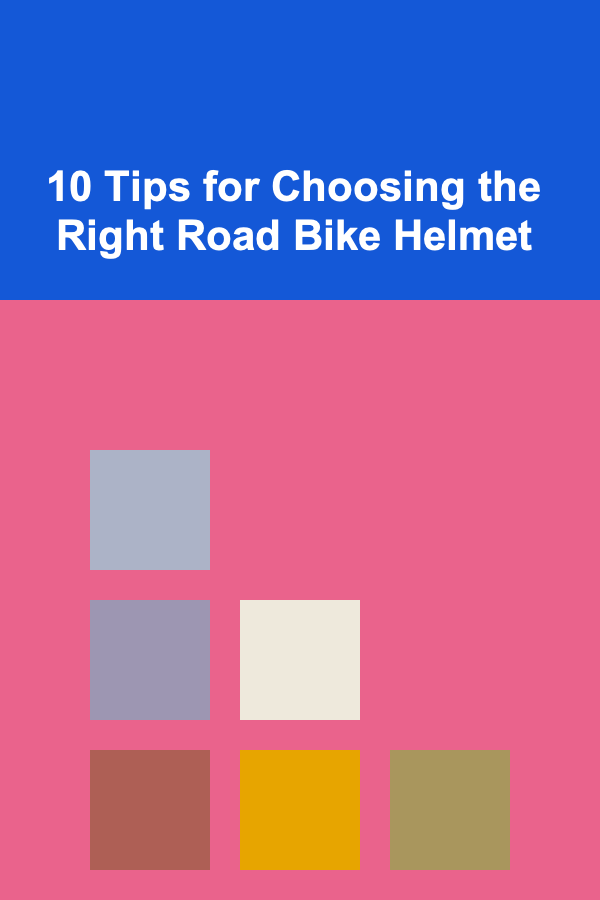
10 Tips for Choosing the Right Road Bike Helmet
ebook include PDF & Audio bundle (Micro Guide)
$12.99$7.99
Limited Time Offer! Order within the next:

Cycling is a fantastic way to stay active, enjoy the outdoors, and get from one place to another. Whether you're commuting, training for a race, or simply riding for fun, one essential piece of equipment you'll need is a road bike helmet. Helmets not only protect your head in the event of an accident but also play a crucial role in ensuring comfort, ventilation, and performance while riding.
With so many helmets on the market, choosing the right one can be overwhelming. There are countless brands, designs, and features to consider. To help you navigate this decision, we've compiled 10 essential tips for choosing the right road bike helmet for your needs.
Consider Safety Certifications
The most important function of a bike helmet is to protect your head in case of a crash. Different countries have different safety standards for helmets, so it's crucial to ensure that the helmet you choose meets the required certifications.
- CPSC (Consumer Product Safety Commission): In the U.S., helmets should meet the CPSC standard. This certification ensures the helmet is capable of withstanding impact forces in an accident.
- CE EN 1078: In Europe, helmets must meet the CE EN 1078 standard, which includes tests for impact absorption and retention system strength.
- AS/NZS 2063: In Australia and New Zealand, helmets are required to meet this standard.
Look for these safety markings when shopping for a helmet. These certifications help ensure that the helmet has passed rigorous testing to protect you in an accident.
Fit is Key
One of the most critical factors when choosing a road bike helmet is fit. A helmet that doesn't fit properly won't offer optimal protection, and it can be uncomfortable to wear for long periods. Here's how to get the right fit:
- Measure Your Head: Use a soft tape measure to measure the circumference of your head just above your eyebrows. This will give you a good idea of what size helmet you need.
- Adjust the Fit: Most road bike helmets come with an adjustable dial or fit system at the back. This system allows you to fine-tune the fit for comfort and security. Make sure the helmet sits snugly on your head without being too tight, and it should stay in place even if you shake your head.
- Straps: The helmet straps should form a "V" shape under your ears when fastened, and the chin strap should be snug but not too tight. A well-fitted helmet should feel secure but not restrict breathing.
Choose the Right Ventilation
Ventilation is an essential feature of any road bike helmet. The more ventilation holes the helmet has, the better airflow you'll get, which helps regulate your body temperature during intense rides. When considering ventilation, think about:
- Temperature and Weather Conditions: If you're cycling in hot climates or during summer months, look for a helmet with plenty of vents to keep you cool. Conversely, if you ride in colder weather, consider helmets that provide some wind protection while still offering adequate airflow.
- Balance of Ventilation and Aerodynamics: Road bike helmets are designed to strike a balance between ventilation and aerodynamics. High-end helmets tend to have more vents but may sacrifice some aerodynamics. If speed and performance are your priorities, you may prefer a more aerodynamic helmet with fewer vents, as it will reduce drag.
Think About Aerodynamics
Aerodynamics is a key consideration if you're serious about speed. A well-designed aero helmet can reduce drag, allowing you to ride faster with less effort. Aero helmets are often slightly more expensive but can provide significant performance gains for competitive cyclists.
- Sleek Design: Aero helmets are often sleek and more streamlined than standard helmets. They may have fewer vents, but the ones they do have are designed to optimize airflow.
- Wind Tunnel Testing: Many high-performance road bike helmets undergo wind tunnel testing to optimize their aerodynamic profile. If speed is your primary concern, look for helmets that have been tested for aerodynamics.
Consider Weight and Comfort
A lightweight helmet can make a big difference, especially during long rides. Heavier helmets can cause neck strain or discomfort over extended periods. The weight of the helmet is typically proportional to its materials and construction.
- Lightweight Materials: High-end helmets use lightweight materials like carbon fiber or advanced polycarbonate shells. These materials offer excellent protection without adding unnecessary weight.
- Padding and Lining: Comfort isn't just about weight; the interior of the helmet matters too. Look for helmets with plush, moisture-wicking pads to keep sweat out of your eyes and prevent discomfort during long rides.
Consider Helmet Shape
The shape of a helmet is important because it should fit the shape of your head. Not all heads are the same, so finding a helmet that fits well and feels comfortable is key. There are a few different types of helmet shapes:
- Round Heads: If you have a round head shape, look for a helmet that offers a deeper fit and more coverage at the back of the head.
- Intermediate Oval Heads: This is the most common head shape, and most helmets on the market will fit this shape well.
- Long Heads: If you have a long head shape, look for a helmet with a longer, more oval shape to ensure proper coverage and comfort.
Some brands cater to specific head shapes, so it may be helpful to try on different helmets to see which feels best.
Look for Extra Features
Road bike helmets often come with a variety of extra features that can enhance your cycling experience. While these features aren't strictly necessary, they can improve convenience, safety, and comfort.
- Visors: Some helmets come with integrated visors that protect your eyes from the sun and debris. This is especially useful if you're cycling in areas with bright sunlight or dust.
- MIPS Technology: MIPS (Multi-Directional Impact Protection System) is a technology used in some helmets that reduces rotational forces during an impact. This can help reduce the risk of brain injury in certain types of crashes.
- Reflective Elements: Many helmets come with reflective elements to increase your visibility, particularly when riding in low-light conditions. Look for helmets with reflective stickers or bright colors if visibility is a concern.
Check the Helmet's Durability
A helmet should provide protection for the long haul. However, it's important to note that helmets have a limited lifespan, as the foam inside them can break down over time.
- Shell Material: The outer shell of a helmet is typically made of polycarbonate, which is strong and durable but also lightweight. Some helmets may feature more advanced materials like carbon fiber, which is even lighter and stronger.
- Replace After a Crash: Even if your helmet doesn't show visible signs of damage, it's important to replace it if you've been involved in a crash. The foam inside a helmet is designed to compress during an impact, and it may not offer full protection if it's been compromised.
Choose the Right Price Range
Road bike helmets come in a wide range of price points, and while you don't necessarily have to spend a fortune, you should be mindful of the quality you're getting for the price.
- Entry-Level Helmets: These helmets are generally affordable and offer good protection but may lack advanced features like aerodynamics, extra vents, or lightweight materials.
- Mid-Range Helmets: These helmets typically offer a good balance of comfort, safety, and features. They may include better ventilation, more advanced materials, and additional comfort features.
- High-End Helmets: These helmets are often lightweight, aerodynamic, and packed with advanced features like MIPS technology, carbon fiber construction, and superior ventilation. They are designed for serious cyclists or competitive athletes.
Try Before You Buy
If possible, it's always a good idea to try on the helmet before making a purchase. Helmets should feel snug and secure, and they should not move around or cause discomfort. If you're buying online, check the store's return policy in case the helmet doesn't fit properly.
- In-Store Trials: Many bike shops allow you to try on helmets to check the fit, comfort, and sizing.
- Online Reviews: If you're buying online, make sure to read reviews from other cyclists to get a sense of how the helmet fits, performs, and feels.
Conclusion
Choosing the right road bike helmet is a personal decision that depends on your cycling style, goals, and preferences. By considering factors like safety certifications, fit, ventilation, aerodynamics, and extra features, you can find a helmet that not only provides excellent protection but also enhances your cycling experience. Whether you're a competitive racer or a casual rider, investing in a quality helmet will help keep you safe and comfortable on every ride.
Take your time, try different helmets, and choose the one that makes you feel secure and confident. After all, your safety and comfort on the road should always be your top priority.
Reading More From Our Other Websites
- [Personal Finance Management 101] How to Create a Debt Snowball or Avalanche Plan to Manage Multiple Debts Effectively
- [Star Gazing Tip 101] Celestial Storytelling: Turning Star-Gazing Into an Immersive Narrative Experience
- [Home Storage Solution 101] How to Make Your Small Apartment Feel Bigger with Smart Storage Solutions
- [Scrapbooking Tip 101] The Ultimate Scrapbook Supply Closet: Step-by-Step Organization Guide
- [Organization Tip 101] How to Communicate with Your Moving Company Effectively
- [Home Budget 101] How to Organize Your Home Budget to Save Time and Money
- [Whitewater Rafting Tip 101] Beyond the Rapids: Exploring the Hidden Gems Around Popular Rafting Destinations
- [Personal Financial Planning 101] How to Create a Comprehensive Financial Plan for Couples: A Step-by-Step Approach
- [Screen Printing Tip 101] Eco-Friendly Screen Printing at Home: Sustainable Inks and Reusable Screens
- [Organization Tip 101] How to Create a Visual Document Timeline for Projects

How to Create an Outdoor Tool Station for Quick Access
Read More
How to Integrate Technology into Your Entryway Organization
Read More
How to Select Energy-Efficient Bulbs for Your Home
Read More
How to Set the Mood with Lighting for Your Home Party
Read More
How to Use Lighting to Create the Perfect Ambiance for Entertaining
Read More10 Tips for HOA Board Members: Mastering Expense Tracking
Read MoreOther Products

How to Create an Outdoor Tool Station for Quick Access
Read More
How to Integrate Technology into Your Entryway Organization
Read More
How to Select Energy-Efficient Bulbs for Your Home
Read More
How to Set the Mood with Lighting for Your Home Party
Read More